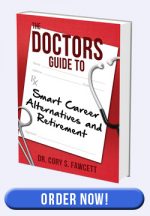(Today’s guest post come to you from David Rosenstrock, who is a certified financial planner with an MBA and the Founder of Wharton Wealth Planning, LLC.)
As a physician, when you end the workday with your patients and your team and walk out the door you may not have a lot left to give to other aspects of your life. Focusing on personal finance issues, the economy, and the stock market likely doesn’t seem like a priority when you are in that moment. Taking the right action steps and strategies can significantly increase your chances at having success and increasing your financial security and freedom. Errors can really compound, so pursuing the right strategies is crucial. Winston Churchill may have summarized it best with respect to his thought on change, “There is nothing wrong with change, if it is in the right direction”.
Most of us look forward to retirement, but it can be a very stressful transition. There are many wealth planning strategies you can pursue to increase the chance that your golden years will truly be enjoyable. Below is a brief guide to maximizing retirement savings and avoiding costly mistakes in retirement planning. A secure, happy retirement requires savvy planning, saving and investing.
1. Choose the Optimal Retirement Age. Staying on the job a few additional years can boost your income in retirement by one-third or more. Social Security defines age 66 as the typical retirement age for most people, but many Americans don’t wait that long. You can avoid the early filing benefit reductions imposed by Social Security by working until your full retirement age (as defined by the IRS). At the same time, you can keep contributing to your retirement-savings plan, building additional balances that can be invested in the market.
For many people, retirement means transitioning from the full-time career or job they’ve held for many years. But there are many other possibilities, including: part-time work in your current practice, mentoring young doctors or trying a volunteer job for a cause you believe in.
2. Take Social Security at the Right Age. The majority of retirees choose to begin receiving Social Security payouts within a few months after turning age 62 or immediately after they stop working, even though it is almost always beneficial to delay the benefits. A National Bureau of Economic Research working paper, written by Stanford economist John B. Shoven, concludes that most retirees are leaving money on the table.There are “spikes” in the retirement age data at ages 62 and 65. Some psychologists argue that early Social Security eligibility at age 62 and perception of “normal” retirement age at 65 serve as reference points that influence peoples’ decisions to retire at these ages.
3. Use a Retirement Projections Calculator. It’s important to consider how your income and expenses will change in retirement. Every person who plans to retire should use a retirement calculator in order to determine just how much money they will need in order to retire while maintaining a comfortable standard of living. Some expenses like health care and travel are likely to increase, but many pre-retirement recurring expenditures could be reduced or eliminated.
According to the Employee Benefits Research Institute, while median household expenses decline with age, housing-related expenses remain the single largest spending category. Healthcare expenses are the second-largest component, and these steadily increase with age.
The 4% rule is a guideline stating that you should take out only about 4% of your retirement savings annually. Each person’s situation is unique but having some guidelines can help you prepare.
4. Evaluate and Factor in Future Health Care Costs. Health care costs pose one of the most serious risks to retirement security, so it’s important to understand how to plan for this major expense and navigate the system. A study from the Employee Benefit Research Institute estimates that a couple with drug costs at the 90th percentile throughout retirement would need savings of about $325,000 by age 65 to have a chance of covering their health care expenses during retirement. Even for those on Medicare, health care costs can still erode spending power. Out-of-pocket expenses for people in retirement have risen over 50 percent since 2002. Long-term care costs can be even less predictable than out-of-pocket costs. About half of people 65 and over won’t incur any long-term care expenses, and an additional quarter will pay less than $100,000. Fifteen percent, however, will pay $250,000 or more.
5. Estimate How Long You’ll Live. Evidence suggests a prevailing tendency for people to underestimate their longevity. There are gender, socio-economic and health differences in longevity estimates but in general people do not appear to understand the true extent of the risk. In order to have enough money for your retirement, many retirement experts suggest that you plan to live into your late eighties, or even your nineties. Planning to live only into your seventies could mean that you will run out of money early as you outlive your expectations.
6. Choose the Correct Investment Strategy. There are many investment strategies available, from aggressive to conservative. Generally those who are younger are advised to invest more aggressively, tapering to more secure investments as they grow older.
When you retire, you’ll have to rely on your accumulated assets for income. To ensure a consistent and reliable flow of income for the rest of your lifetime, you must provide some safety for your principal. It’s common for individuals approaching retirement to shift a portion of their investment portfolio to more secure income-producing investments, like bonds.
Unfortunately, safety comes at the price of reduced growth potential and the risk of erosion of value due to inflation. Safety at the expense of growth can be a critical mistake for those trying to build an adequate retirement funding strategy. On the other hand, if you invest too heavily in growth investments, your risk is heightened.
It is common for a retiree who has worked at the same company for many years to accumulate a large amount of that company’s stock in his or her portfolio. Some retirees choose not to diversify because they have comfort in being invested in their employer’s stock. A retiree’s investment portfolio, however, should hold no more than 5% to 10% of any one particular stock, so that the portfolio can be protected and properly diversified for risk management purposes.
7. Manage Taxes and Choose the Right Sequence In Which You Draw from Your Retirement Accounts. It is also important to match different types of accounts (i.e. taxable, retirement, etc.) with particular investment strategies. Not regularly contributing to tax efficient accounts is a common mistake in financial planning. Making increased contributions to retirement accounts including 401(k), 403(b), IRA, SEP IRA, Roth IRA, Spousal IRA (spouse not in workforce), and “backdoor” Roth IRAs can help put you on track to be prepared for retirement.
Probably the best way to accumulate funds for retirement is to take advantage of IRAs and employer retirement plans like 401(k)s, 403(b)s, and 457(b)s. The reason these plans are so important is that they combine the power of compounding with the benefit of tax-deferred (and in some cases, tax free) growth. For most people, it makes sense to maximize contributions to these plans, whether it’s on a pre-tax or after-tax (Roth) basis.
No two people will have the exact same return on their retirement savings accounts. But, those who follow a specific long-term investment plan can expect to have better average returns than those who do not.
8. Be Aware that there are Different Types of Financial Advisors and If You Self-Manage, Consider Seeking a Second Opinion. The type of advisor you choose (or don’t choose) will likely have a big impact on your financial future and well-being. There are many conflicts of interest that exist in the financial advisory world today. Knowing what type of advisor you are working with will help you understand what questions you need to ask to protect yourself.
There are three broad types of classifications used for financial professionals:
1. The first is a Fiduciary (or Investment Advisor Representative of a Registered Investment Advisory Firm). According to the SEC this category represents approximately 12% of advisors today.
2. The second is a Non-Fiduciary (or a Registered Representative of a Broker/Dealer). According to the SEC this category represents approximately 27% of advisors today
3. The last category is a Hybrid (or A combination of one and two). According to the SEC this category represents approximately 61% of advisors today
Advisors who possess a fiduciary duty to their clients are required to put their clients’ best interests above their own at all times. Many people are surprised to find out that this obligation isn’t required of all advisors. In fact, most advisors aren’t required to act as a fiduciary in all their interactions with a client. Advisors who are not fiduciaries often follow the suitability standard, but that only requires that they give clients advice deemed “suitable” for their situations, thus it offers fewer protections/safeguards to clients. It is important to be aware that advisors with series 7, 63, or 66 licenses are allowed to collect commissions on the sale of investment products… and these fees may or may not be clearly disclosed and transparent to the client. There are many well regarded regional and national brand name storefronts that do not follow fiduciary standards and this may be in direct conflict with what is in the best interest of prospective clients.
9. Put a Plan in Writing with the Correct Updated Assumptions. While most people who are near retirement age have a sense of how much assets they have accumulated and how much they will need to spend in retirement, most people fail to have those numbers checked against different market condition scenarios. Potential retirees should consider testing and updating their plans using a wide range of market returns assumptions, including rate of inflation and other macro factors. This assumption-testing process can bring to light flaws in a retirement plan while there is still time to take action in advance of retirement.
According to the Transamerica Center for Retirement Studies, although 58% of retirees had a financial strategy for retirement during the coronavirus pandemic, only 18% had it in writing. A written financial plan is essential as it helps ensure that your savings will last. Facts that need to be considered include debt repayment, living expenses, investments and returns, taxes, as well as the need for long-term care.
As the world economy struggles and inflation continues to persist, one needs to challenge the conventional wisdom regarding expected annual rate of return, inflation rate, GDP growth, etc., because any one of these factors can easily derail a carefully crafted retirement plan.
Retirement should be a time of freedom, enjoyment, and security, and there shouldn’t be a lot of significant stress and distractions. But in order to make this happen, retirement needs to be planned for. Everyone has to expect and plan for the unexpected. Some are going to be very fortunate and hit the lottery, while others might end up needing significant long-term care, and it’s just not possible to predict. There are so many different variables. However, those that follow a specific financial plan are likely going to do better than those who don’t. They’re going to have better average returns on their portfolios and probably a little bit more comfort in retirement.
David Rosenstrock is the Director and Founder of Wharton Wealth Planning, LLC. He earned his MBA from the Wharton Business School and B.S. in economics from Cornell University. He is also a CERTIFIED FINANCIAL PLANNER™. David lives in New York with his wife and their two very active children.










Saw this 2018 (updated 2020) report from US News after I hit submit. “In recent years, full retirement age has become the most popular age to claim payments.” Even better news, but they don’t include their source data.
https://money.usnews.com/money/retirement/social-security/articles/the-most-popular-ages-to-collect-social-security
As always, enjoy reading your material.
I would point out the statement “The majority of retirees choose to begin receiving Social Security payouts within a few months after turning age 62 or immediately after they stop working.” feeds into the narrative that most people take social security at 62. In fact it has been on a steady decline since 1995 and in 2020, 25% of people claimed at 62 (paper below, Figure 4). You did leave considerable wiggle in your statement, but I wanted to point out the work of the financial literacy community is not falling on deaf ears as more and more people are taking it later. There was a blip in the great recession but none during COVID. The second study below says, “…workers who delay are claiming in their mid-60s or later…”, so it is not a matter of people just claiming a few months late. I definitely agree with your premise that most people would benefit by waiting, but wanted to show there has been significant progress.
https://crr.bc.edu/social-security-claiming-covid-19-vs-great-recession/
https://crr.bc.edu/pre-covid-trends-in-social-security-claiming/